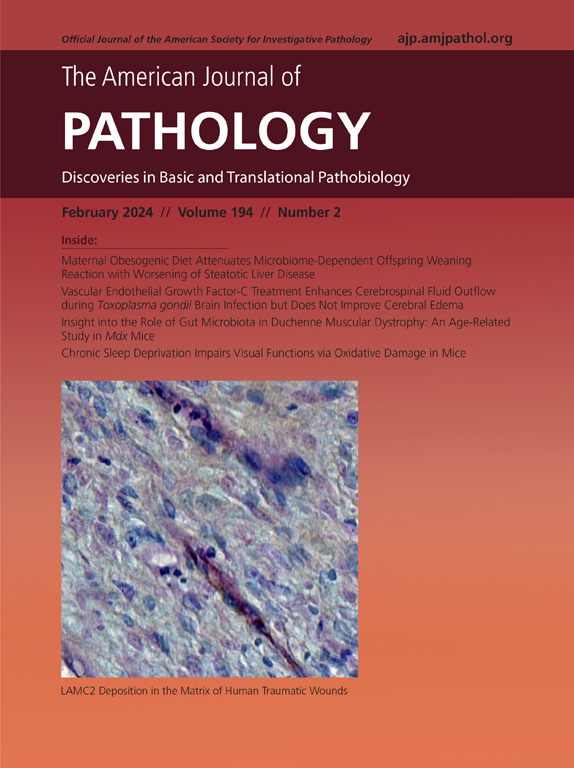Nitric Oxide May Adversely Affect the Metabolism and Viability of Retinal Organoids Derived from Patients with Leber Hereditary Optic Neuropathy
IF 3.6
2区 医学
Q1 PATHOLOGY
引用次数: 0
Abstract
Leber hereditary optic neuropathy (LHON) is a bilateral optic neuropathy associated with mitochondrial DNA (mtDNA) mutations characterized by parapapillary telangiectasia during the acute phase. However, its precise mechanism remains unclear. This study evaluated the effects of nitric oxide (NO) on retinal organoids (ROs) generated from induced pluripotent stem cells derived from patients with LHON. Established induced pluripotent stem cells from three patients with the m.11778G>A mutation (patient group) and three healthy individuals (control group) were differentiated into ROs. Changes in cell death ratios, mtDNA copy number, and metabolite profiles in the ROs following exposure to sodium nitroprusside (SNP), which was an NO donor, were compared between the two groups. At baseline, terminal deoxynucleotidyl transferase-mediated dUTP nick-end labeling–positive cell ratios did not differ significantly, whereas the mtDNA copy number was significantly higher in the patient group. SNP exposure significantly increased the proportion of terminal deoxynucleotidyl transferase-mediated dUTP nick-end labeling–positive cells in the patient group but did not affect the mtDNA copy number. Relative concentrations of metabolites, including taurine and γ-aminobutyric acid, were initially reduced in the patient group, but increased following SNP exposure. These findings suggest that NO may promote retinal cell death and disrupt metabolite profiles in ROs derived from patients with LHON.
一氧化氮可能对Leber遗传性视神经病变患者视网膜类器官的代谢和活力产生不利影响。
Leber遗传性视神经病变(LHON)是一种与线粒体DNA (mtDNA)突变相关的双侧视神经病变,其特征是急性期乳头旁毛细血管扩张。然而,其确切机制尚不清楚。本研究评估了一氧化氮(NO)对来自LHON患者的诱导多能干细胞(iPS)产生的视网膜类器官(ROs)的影响。将3例m.11778G>A突变患者(患者组)和3例健康个体(对照组)的iPS细胞分化为ROs。比较两组暴露于硝普钠(SNP) (NO供体)后细胞死亡率、mtDNA拷贝数和ROs代谢物谱的变化。基线时,末端d-UTP缺口末端标记(TUNEL)阳性细胞比率无显著差异,而患者组的mtDNA拷贝数明显较高。SNP暴露显著增加了患者组中tunel阳性细胞的比例,但不影响mtDNA拷贝数。包括牛磺酸和GABA在内的代谢物的相对浓度在患者组中最初降低,在SNP暴露后增加。这些发现表明,NO可能会促进视网膜细胞死亡,并破坏LHON患者ROs的代谢物谱。
本文章由计算机程序翻译,如有差异,请以英文原文为准。
求助全文
约1分钟内获得全文
求助全文
来源期刊
CiteScore
11.40
自引率
0.00%
发文量
178
审稿时长
30 days
期刊介绍:
The American Journal of Pathology, official journal of the American Society for Investigative Pathology, published by Elsevier, Inc., seeks high-quality original research reports, reviews, and commentaries related to the molecular and cellular basis of disease. The editors will consider basic, translational, and clinical investigations that directly address mechanisms of pathogenesis or provide a foundation for future mechanistic inquiries. Examples of such foundational investigations include data mining, identification of biomarkers, molecular pathology, and discovery research. Foundational studies that incorporate deep learning and artificial intelligence are also welcome. High priority is given to studies of human disease and relevant experimental models using molecular, cellular, and organismal approaches.

 求助内容:
求助内容: 应助结果提醒方式:
应助结果提醒方式:


